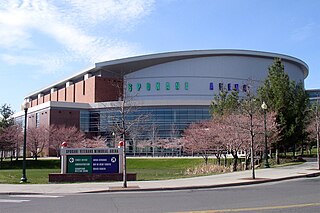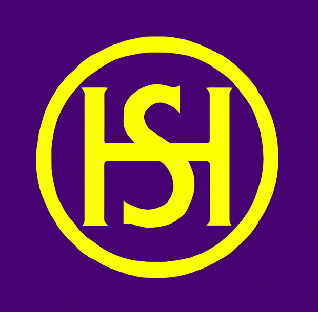Related Research Articles

Spokane is the most populous city in eastern Washington and the county seat of Spokane County, Washington, United States. It lies along the Spokane River, adjacent to the Selkirk Mountains, and west of the Rocky Mountain foothills, 92 miles (148 km) south of the Canadian border, 18.5 miles (30 km) west of the Washington–Idaho border, and 279 miles (449 km) east of Seattle, along Interstate 90.
The Pacific Coast Hockey Association (PCHA) was a professional ice hockey league in western Canada and the western United States, which operated from 1911 to 1924 when it then merged with the Western Canada Hockey League (WCHL). The PCHA was considered to be a major league of ice hockey and was important in the development of the sport of professional ice hockey through its innovations.
The Seattle Metropolitans were a professional ice hockey team based in Seattle, playing in the Pacific Coast Hockey Association (PCHA) from 1915 to 1924. During their nine seasons, the Metropolitans were the PCHA's most successful franchise, as they went 112–96–2 in their nine years as a franchise. The Metropolitans also won the most regular season PCHA championships, winning five times, with Seattle finishing second on three other occasions. The Metropolitans played their home games at the 2,500 seat Seattle Ice Arena located downtown at 5th and University.

The Victoria Cougars were a major league professional ice hockey team that played in the Pacific Coast Hockey Association (PCHA) from 1911 to 1924 under various names, and in the Western Hockey League (WHL) from 1924 to 1926. The team was based in Victoria, British Columbia, and won the Stanley Cup in 1925, becoming the final non-NHL team to win the Cup.
The Pacific Coast Hockey League was an ice hockey minor league with teams in the western United States and western Canada that existed in three incarnations: from 1928 to 1931, from 1936 to 1941, and from 1944 to 1952.

Spokane Veterans Memorial Arena is a multi-purpose arena in the northwestern United States, located in downtown Spokane, Washington. Opened in 1995, it is home to the Spokane Chiefs of the Western Hockey League (WHL).

Denman Arena was an indoor arena located in the West End neighbourhood of Vancouver, British Columbia. The arena was located at 1805 West Georgia Street at the northwest corner with Denman Street. It opened in December 1911 and was destroyed by fire in 1936. Its primary use was for ice sports such as ice hockey. It was the home ice rink of the Vancouver Millionaires professional ice hockey team, and was the location of the 1915 Stanley Cup championships. The arena was also used for other sports, musical performances, and public assemblies. It was an assembly point for Canadian servicemen during World War I. The 10,500-seat arena was the largest in Canada at the time, and introduced mechanically frozen or "artificial" ice to Canada.

Patrick Arena (1911–1929) was the main sports arena located in the Greater Victoria, British Columbia area. The wood construction, brick-faced arena was located in the suburb municipality of Oak Bay, on the northeast corner of Cadboro Bay Road and Epworth Street. Built in 1911 at a cost of $110,000 with a capacity for 4,000 spectators, it officially opened with public skating on December 25, 1911. More than 600 skaters enjoyed the thrill of opening day. The owners, Frank and Lester Patrick, built the arena primarily to accommodate their hockey team in the newly formed Pacific Coast Hockey Association (PCHA). The Patrick Arena was destroyed by fire in 1929.

The New Westminster Royals was the name of several professional ice hockey teams based in New Westminster, British Columbia, first established in 1911 for the Pacific Coast Hockey Association (PCHA). Though nominally based in New Westminster, the team played its home games at the Denman Arena in nearby Vancouver, as an arena was not available; the team would never play a PCHA home game in New Westminster as a result. They won the inaugural PCHA championship in 1912, though financial difficulties saw the team relocated to Portland, Oregon in 1914 and become the Portland Rosebuds.

The Spokane Canaries were a professional ice hockey team in Spokane, Washington. They played in the Pacific Coast Hockey Association for only one season in 1916–17. In the fall of 1916, the Canadian government expropriated the Patrick Arena in Victoria, British Columbia for war-time training purposes, making the arena unavailable for ice hockey use. It was decided to move the club based there, the Victoria Aristocrats, to Spokane, Washington. The team operated without an official nickname but were dubbed the "Canaries" by a local boy after seeing their yellow and purple uniforms. The team was a flop at the gate drawing poor crowds. As a result of this, on February 15, 1917, it was announced that most of the team's home games would subsequently be moved to the Seattle Ice Arena. As well what was to be their final home game against the Vancouver Millionaires would be cancelled. The team would fold at season's end. Two years later the club was reactivated in Victoria to become the Victoria Aristocrats again.

The Seattle Ice Arena was a 4,000-seat multi-purpose arena in Seattle, Washington, United States. It was home to the Seattle Metropolitans Pacific Coast Hockey Association franchise from 1915 to 1924.

Lloyd Tramblyn "Farmer" Cook was a Canadian professional ice hockey defenceman. He played for the Vancouver Millionaires/Maroons and Spokane Canaries of the Pacific Coast Hockey Association and for the Boston Bruins of the National Hockey League. He won the Stanley Cup in 1915 with the Millionaires and was named to the PCHA first all-star team three times.

Sebastian John "Sibby" Nichols was a Canadian professional ice hockey player who played 110 games in various amateur and professional leagues, including the Eastern Canada Amateur Hockey Association and Pacific Coast Hockey Association. Amongst the teams he played with were the Montreal Shamrocks, Vancouver Millionaires, Victoria Aristocrats, Spokane Canaries, and Seattle Metropolitans. He also played lacrosse with the Vancouver Lacrosse Club.
The 1916–17 PCHA season was the sixth season of the professional men's ice hockey Pacific Coast Hockey Association league. Season play ran from December 1, 1916, until March 2, 1917. The season was expanded to 24 games per team, except that the final game was cancelled. The Seattle Metropolitans club would be PCHA champions. After the season the club would play the Stanley Cup finals series against the Montreal Canadiens, NHA champions. Seattle would win the best-of-five series 3–1 to win the Cup.

Norman Boswell "Hec" Fowler was a two-sport athlete from Canada. He was a professional ice hockey goaltender who played in the Pacific Coast Hockey Association and National Hockey League between 1916 and 1925. He was also a soccer goalkeeper for Saskatoon Thistle.

Spokane, Washington has a rich sporting culture and the area residents are active in many spectator and participant sports. Although Spokane lacks any major, nationally recognized professional sports team, Spokane has a sports friendly atmosphere, and was recognized and rated #99 in the Sporting News 2006 "99 Best Sporting Cities" list. In 2009, Sports Business Journal rated Spokane as the fifth best minor league sports market in America out of 239 markets.

The Toyota Center is a multi-purpose arena in the northwest United States, located in Kennewick, Washington.

John Leo Falconbridge Cook was a Canadian professional ice hockey player. He played with the Spokane Canaries and Vancouver Millionaires of the Pacific Coast Hockey Association, as well as the Regina Capitals and Edmonton Eskimos of the Western Canada Hockey League. He died in 1964.
The following is a timeline of the history of the city of Spokane, Washington, USA.

The Seattle Kraken are a professional ice hockey team based in Seattle. The Kraken compete in the National Hockey League (NHL) as a member of the Pacific Division in the Western Conference. The team was founded after the NHL approved a proposal by Seattle Hockey Partners to grant an expansion franchise to the city of Seattle, and the team began play during the league's 2021–22 season. They play their home games at Climate Pledge Arena.
References
Notes
- 1 2 3 4 Inlander Staff (January 15, 2004). "The Puck Passes". Inlander. Retrieved July 29, 2023.
- ↑ Empire of Ice: The Rise and Fall of the Pacific Coast Hockey Association, 1911–1926, Craig H. Bowlsby, pg. 108–109
- ↑ Carter, Max (December 8, 2015). "Spokane Chiefs pay tribute to city's hockey roots Dec. 19". Inlander. Retrieved July 29, 2023.